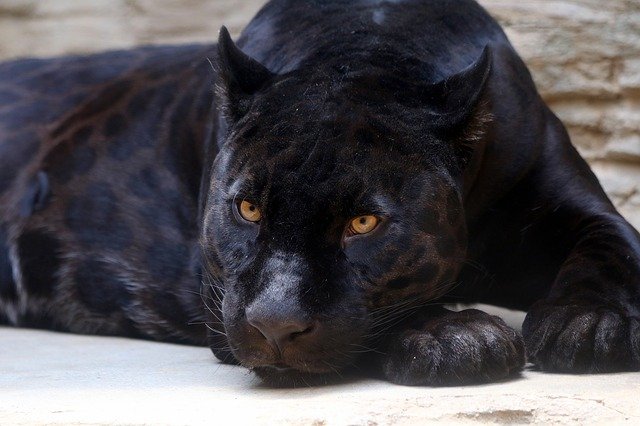Nature is wonderful and sometimes tricky. It is always changing and always adapting. To adapt to nature some animals also adapt themselves accordingly, its best-known example is melanistic animals. Melanistic animals are incredible and you can call them the truest creatures of the night.
They are pitch black often unnoticeable and allusive at night, they are nature’s wonder. Melanism is caused by the increased presence of a black-colored pigment in the skin. The term Melanism refers to black pigment. The black specimens are called “melanic,” “melanistic,” or “black morphs.”
Melanism is is the opposite of albinism which occurs due to the lack of melanin. In albinism, the creature becomes pure white. The word ‘melanism’ is deduced from a Greek word that means black pigment.
There is also Pseudo-melanism, also called Abundism, which is another variant of pigmentation, Abundism is an increase in dark pigmentation in patterned coats or skins which causes an increase in the number or size of pigmented spots, stripes, or other patch types. Abundism is characterized by dark spots or enlarged stripes, which cover a large part of the body of the animal making it appear melanistic.
Melanism is often the result of genetic mutation but can result from other factors such as exposure to abnormal temperature changes during gestation which transiently alter gene transcription or translation. It is triggered by human modification of the environment is known as industrial melanism.
Melanism is an adaptive technique for animals. Dark animals become fitter to survive and reproduce in their environment as they are better camouflaged. Melanistic animals are also difficult to spot at night. It helps some prey animals to hide better from predators, and at the same time, it improves the stealth of some predators.
Melanism is heritable, but it’s carried by recessive genes, so sometimes it can skip a few generations before it appears again. Melanistic animals can be born from “normal” parents and vice versa. Oftentimes melanistic and non-melanistic siblings can appear in the same family.
Below you will find the fascinating 20 melanistic animals.
20. Melanistic Big Cats (Black Panthers)
Leopards and Jaguars with melanism are often called Black panthers, although cougars are also known as panthers, there are no verified cases of melanism in that species. Black panthers are the most common melanistic animals in nature.
There is a common misconception that black panthers are a separate species. Actually, they’re just a leopard or jaguar with an over-development of melanin.

19. Melanistic Wolf
A black wolf is a melanistic color variant of a gray wolf. Black specimens were recorded among red wolves, though the color morph in this species is probably now extinct. Melanistic Grey Wolves still exist. However, melanistic Red Wolves are now extinct.

18. Melanistic King Penguin
Melanism is common in many different animal species, the trait is extremely rare in penguins. All-black penguins are so rare there is practically no research on the subject–biologists guess that perhaps one in every quarter million penguins shows evidence of at least partial melanism, whereas the penguin below in the picture is almost entirely melanistic.

17. Melanistic Zebra
The zebra below in the picture has a condition called pseudo melanism, a rare genetic mutation in which animals display some sort of abnormality in their stripe pattern.

16. Melanistic Deer
Melanistic deer lack distinct variations in color such as brown or white. Most melanistic deers are black across their entire body with the exception of the hair around the ventral area under the tail. White-Tail Deer can also have white coats or black coats.
Both types of coats are rare, but black coats are the rarer of the two. They can either be all-black or dark chocolate brown. But the deer in the below picture is full black.

15. Melanistic Red Fox
Black foxes are basically melanistic red foxes. They may also be called silver foxes because the black coats around their hindquarters sometimes have silver tips. Some are completely black except for a white coloration on the tip of the tail, giving them a silvery appearance. Some silver foxes are bluish-grey, and some may have ash-grey color on the sides.

14. Melanistic Lizards
The presence of totally black-colored individuals is quite common in reptiles. Melanism is well documented in many European reptile species, with both entire populations. Eastern Blue Tongue Lizards is very rare. The eastern blue-tongue lizard is one of the most familiar reptiles in Australia.

13. Melanistic Squirrels
Black squirrels are melanistic squirrels with black coloration on their fur. This phenomenon occurs with several species of squirrels, although it is most common in the eastern gray squirrel and the fox squirrel.

12. Melanistic Rabbits
European rabbits come in various colors. The fur of the European rabbit is generally greyish-brown, but this is subject to many variations and one of these many colors is all-black. Melanistic rabbits are common in Mainland Europe, and they typically live on islands and large enclosures.

11. Melanistic Turtles
Melanism in turtles occurs in the species Red-eared slider also known commonly as the red-eared terrapin, red-eared slider turtle, red-eared turtle, slider turtle, and water slider turtle, is a subspecies of the semiaquatic turtle.
Their skin is darker showing signs of melanism to the point where the normal yellow stripes on their necks are no longer visible. Melanism has been noted in male Red-Eared Sliders, and it is related to old age.

10. Melanistic Serval Cats
Many pet cat species are jet black, but it is very rare in the wild serval cats. Melanism is common enough among wildcats—it’s reported in 13 of the 38 known species, the trait seems to be relatively very rare in servals cats. Normally, Servals have buff tan or golden-yellow coats with black spots. Melanistic serval cats have a pure black coat.

9. Melanistic Manta Rays
While typical manta rays are dark grey on their backs and mostly white on their undersides, melanistic mantas are completely black on their backs and almost entirely black on their underside with a central white blaze that varies in size and shape, and can be used to identify individuals.
Melanism is far less common underwater. Of the hundreds of species of cartilaginous fish in the ocean, only two known species of manta rays — exhibit this trait.

8. Ayam Cemani Chicken
The Ayam Cemani is a rare breed of chicken from Indonesia. Melanism in Ayam Cemani is controlled by a dominant gene. They have a dominant gene that causes hyperpigmentation (fibromelanosis), making the chicken mostly black, including feathers, beaks, tongues, combs, and wattles appearing black.
Even their meat, bones, and organs are black or gray. However, their eggs are white. They are the most expensive chicken in the world.

7. Melanistic Snakes
Melanism has been reported from a wide range of snakes. One of the best-known examples is the Northern Viper (Vipera berus) where melanistic individuals have been found across most of its range and as far north as the Arctic circle in Sweden.
Their color pattern ranges from very light-colored specimens to entirely brown ones with faint or clear, darker brown markings, and on to melanistic individuals that are entirely dark and lack any apparent dorsal pattern.

6. Melanistic Guinea Pigs
Melanistic guinea pigs are rare. In some cases, they are bred specifically to achieve the melanistic trait.

5. Melanistic flamingo
The extremely rare black flamingo was spotted on the Mediterranean island of Cyprus, many experts said it may be the only bird or the second case of its type ever seen.

4. Melanistic Giraffe
Just like the zebra, giraffes can also have pseudo melanism, a rare genetic mutation in which animals display some sort of abnormality in their stripe pattern.

3. Melanistic Cheetah
Apparently, it turns out that cheetahs can also be striped as well as spotted thanks to the Pseudomelanism in their spots pattern.

2. Melanistic Moor Goldfish
The Black Moor is a black-colored variant of a telescope goldfish that is known for its color and protruding eyes. Black telescopes are commonly known as Black Moors, Blackamoors, or just Moors.
The Black moors are said to be melanistic, sort of!. The thing is they don’t remain melanistic for a longer time. The black coloration of the Black Moor Goldfish comes from an excess of melanic pigment deposited in the scales.
Young Moors under 30 days old are bronze with normal eyes, but from five or six weeks of age, the black pigment begins to appear in some early developers along with the telescopic eyes. The highest quality black moors have a velvety appearance and no metallic scales.
A genuine Black Moor which is believed to be melanistic never loses its color, and must not be confused with juvenile telescope fish with black pigmentation.

1. Melanistic Owls
The Barn owl is the most common species of owl in the world and one of the most widespread of all species of birds almost found everywhere in the world. Barn owls are among the most common and loved of all owls. But melanistic Barn owls are extremely rare.
They are killed by their own mothers because of their color and if they somehow survived they are mobbed and killed by the other owls.


